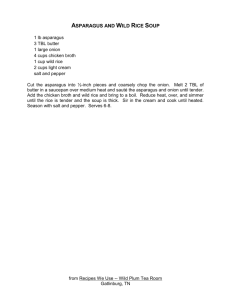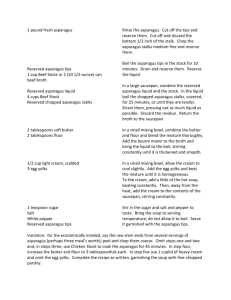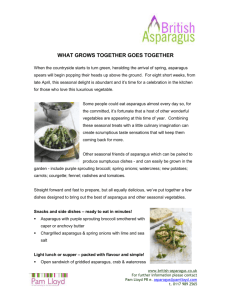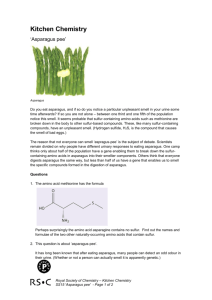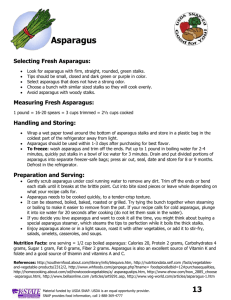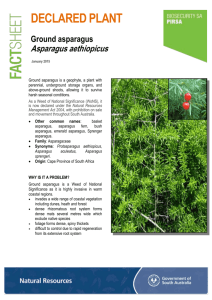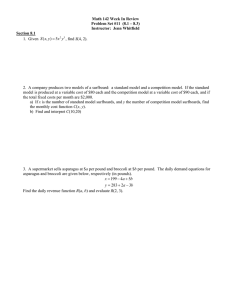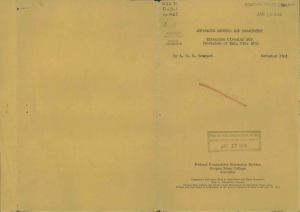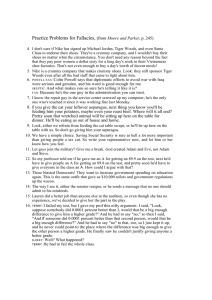Exteron Cnl'1fr '2 fleviiion 0 Circu1ir A. G. B. Bouquet
advertisement
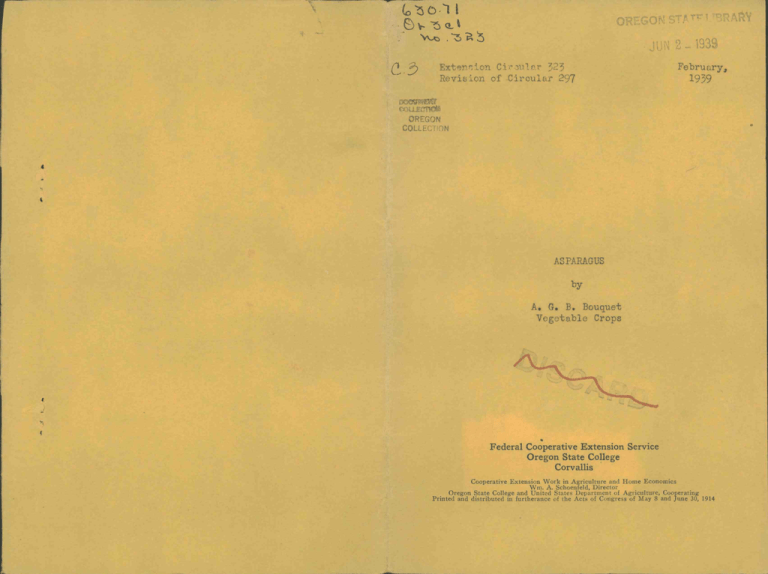
(0c.'1 I Exteron Cnl'1fr '2 fleviiion 0 Circu1ir Februriry, 297 19)9 ORE(Cmi COLt ECT'ON AS FARAGTJS by A. G. B. Bouquet Vegotablo Crops U LI Federal Cooperative Extension Service Oregon State College Corvallis Cooperative Extension Work in Agriculture and Home Economics Wrn. A. Schoenfeld, Director Oregon State College and United States Department of Agriculture, Cooperating Printed and distributed in furtherance of the Acts of Congress of May 8 and June 30, 1914 ASPARAGUS by A. G. B. Bouquet A complete farm home garden should include a planting of asparagus, which is the most important perennial vegetable. The asparagus plantation should be given a place with the rest of the horticultural crops which are more or less permanent, and with rhubarb, also a perennial crop, asparagus should be planted at one side of the garden so that it will not interfere with other vegetables that are planted annually. Asparagus is one of the first vegetables to be harvested in the spring when the garden is almost barren of fresh produce. Once estabU shed, the bed will produce annually for several years. When harvested fresh frori the garden and cooked shortly therefore, asparagus has the finest possible quality. The plant is one that adapts itself well to various soil and climatic conditions, and, as a consequence, it can be grown in almost any portion of this state, acres. Coimuercially, asparagus is grown in Oregon to the extent of several hundred Small areas of this vegetable for local consumption are to be found in the vicinity of the various cities of the state and larger areas of asparaus for shipment are located along the Columbia River east of Portland as far as lJmatilla county. There is also some acreage planted in the Willamette Valley for shipping, canning and freezing purposes. More recently, too, there has been some acreage planted to this crop in eastern Oregon, mostly for processing. In 1937 the estimated value of conmiercial asparagus in Oregon was $180,000 according to U.S.D.A. statistics. From prices of asparagus published by the United States Department of Agriculture, Bureau of Agricultural Economics, values have declined since 1930 when the value per crate was stated to be $2.10. Prices were recorded at $1.50 per crate in 1932, and $1.10 in 193. In 1934 the estimated average price per crate was $1.65, $1.20 in 1935, $1.40 in 1937. The number of cases of asparagus canned in 1935 was a little less than 12,500, which amount had risen to 29,000 in 1937. In the last few years asparagus has come into greater prominence because of its being processed by freezing, and the number of pounds handled in this way in 1937 for Washingi on-Oregon was 910,000. The average price of asparagus delivered for canning or freezing has been between 3-3/4 and 5-1/4 cents per pound. Varieties. The most widely planted variety at the present time is Mary iashington, which isrust-resistant, a vigorous grower, and which produces stalks which are of good shape, length before feathering, color and market quality. If setting out a plantation of asparagus from roots, it is especially important to get a good strain of roots of the variety mentioned, or, if one is growing ones own roots, the seed should come from selected plants, the pedigree and good characters of which are known. Asparagus crowns which are used for starting a plantation are grown from seed in an outdoor seedbed, the plants being grow-n for one full season before being set out in the permanent bed. Prospective growers of asparagus have the option of buying ore-year old crowns, or obtaining selected seed and growing Crowns. their own crowns. There are advantages in either method. If the crop is to be grorm on a rather large scale, it is cheaper to buy pedigreed seed and grow the crowns rather than to buy them, but on a small scale, especially for the home garden, ±t is 'cost to buy the one-year old crowns ready for planting and thus save a year's time. There are some advantages in growing one's own plants, having knowledge of the source and ';roduotiveneas of the parent plants from which the seed came. There is also greater opportunity of selection from the crowns when digging them and sorting them for putting in the permanent bed. iThen buying plants, large one-year old crowns are the best for planting. rthen buying seed, four to five pounds sown on an acre should produce 30,000-40,000 roots, sufficient to set 5 to 7 acres. The asparagus plant produces both mal3 and fema.e plants, of which in the field perhaps 50% are males and 50% females. Some experiments seem to indicate that the male plants may produce slightly larger yields of stalks than the female plants, but certain female plants may produce a slightly bettor grade of asparagus than the male. This question is not one that should in any way concern the grower of 50 to 100 asparagus plants, producing stalks for home consumption. Neither should it be of very groat concern to the corntheroial grower, who provides sufficient fertility for the plantation as a whole. It is interesting to note from observations which have been made of the yields of the highest yielding plants as against the average for all plants in the area that the production of the 10 highest plants was 194% above the average spear production for all plants, while the weight of the stalks from these 10 highest plants was 161% above the weight of stalks from all plants. It can readily be appreciated, therefore, that the more uniform the plants are over the field aè a whole, the greater w.11 be the yields and the hiher the market quality. It is important that the plants be set out in the garden before the crowns have started to make much growth, othoxdse the stalks will oftentimes he broken of f, and thus some of the first year's production of stalks and foliage will be lost. Soils. ghile asparagus is a plant which adapts itself to a wide variety of soils, frorthe standpoint of producing early and straight stalks, a light friable sandy or silt loam is preferred, Soils that are light in i;e:turo and friable have a tendency to produce earlier and straighter asparagus. From a commercial standpoint, therefore, the soils adjacent to rivers are most widely used for asparagus production. In the home garden if the soil is naturally heavy and inclined to be late or unusually moist, plants can be covered with sandy loam or a lighter type of soil after they are put in the trench, which can he gradually filled in with the lighter soil instead of the natural soil of a more compact typo. Fertilizers. It is important to build up the soil to a good state of organic matter and fertility before putting in asparagus plants. It is particularly important that the supply of organic matter in the soil should be maintained at a fairly high level in the early growth of the plants, the organic matter being supplied by manure or cover crops, In established plantings, applicab ions of rotted manure have been beneficial. Fresh manure may contain weed seeds and cause a grassy growth and the necessity of more weed elimination during and after the cutting season. Cover ops of votch turned under in the early spring have increased yi3lds. Poultry manure has sometimes been found beneficial. Broadcasting 3 of a complete fertilizer of 6-6-6 has given good increase in yields. Cyanamid at a rate f possibly 500 pounds per acre has been used to advantage in killing some weeds and providing available nitrogen. This material should be applied broadcast several weeks before the cutting season begins. Some growers have profitably added to it an equal amount of superphosphate. Most of the material from which the shoots are formed in the spring is stored in the fleshy roots, or the crowns, duriig the previous summer and fall. It is, therefore, desirable to have as heavy a top growth of foliage as possible after the cutting season is over, The number of commercial fertilizer applications may vary between one and two depending upon the possibility of irrigation or the amount of rainfall. It would be advantageous to apply some fertilizer after the cutting season provided there is sufficient moisture available to dissolve the fertilizer. It was formerly considered that salt was necessary in growing asaragus, but it is certain that it is not essential, as very good asparagus is grown without the use of it. It would be better to ue commercial fertilizers containing available plant foods which would stixrailate the growth of the plants and a heavier production of stalks, Setting the Roots. The usual distances of setting asparagus plants in the rden re 4-1/2 to 6 feet between the rows and 18 to 30 inches be&ween plants in the raw. These distances vary considerably as to whether the plantation is commercial or one for home use, The rows can be closer together in the home garden or one long row may be sufficient. Commarcially, in view of the horizontal and vertical spreading of the roots of the plants, it is advisable to have them no closer than 2 feet apart in the row, and the rows preferably 5 to 6 feet apart. In California, the large plantings of asparagus are set 20 inches between the plants, with 7-1/2 to 8 feet between the rows. These are the common distances for blanched or white asparagus, while the asparagus that is grown for green cuttings is usually grown at a closer distance. Furrows should be ioade so that the crowns are set at a depth of approximately 8 inches. According to a recent report of the Massachusetts Experiment Station, the results obtained in determining the effect of various depths of planting have shown that deep planting (8 inches) has reduced the stands and thus the yields, while the shallow planted roots (2 to 4 inches) have apparently not been injured by either cultivation or freezing amid thawing. It is, of course, evident that the shallow plantings of 2 to 4 inches are virtually impos;ib1e and impracticable, but it is important to note, on the contrary, that it is commonly inadvisable to set plants deeper than 8 inches Particularly would this be true where the soil was heavy and the stalks would have difficulty in pexetrating a considerable amount of solid soil surface in the spring. Most asparagus roots are sot out during the spring, and, in so doing, the fleshy roots are spread out horizontally in the bottom of the furrow and the crowns covered with about a couple of inches of soil when they are set. Filling in the furrows will take place as the stalks of the plant grow during the spring and summer, Maintenance of the Plantation. Sufficient cultivation should be given between the rows and around the plants of asparagus to keep down weeds and to provide a 4 soil mulch. The larger the growth of tops during the spring, suirmer and fall, the greater will be the cutting the following spring. If water is available for irrigating during the summer, it should by all means be applied as it will cause an increase in the growth of the foliage and the crowns and consequently induce larger future harvestings. It is iradvisable to cut the top growth of the plant until it has ben killed by frost or cold weather. Some growers cut these tops with a mowing machine and rake them into a windrow and burn them. In other cases the tops are disked into the soil in the spring when the land is being prepared for the harvesting season. If -Lho rowa of asparagus are 6 feet or more, it is possible to intercrop with small vegetables between the rows during the first year or so. Carrots, peas, peppers, cabbage, radishes and lettuce are sometimes used. If there should be any plants missing in the rows, the best time to locate these is in the summer of the first year, and then the missing places can be set with crowns during the early spring of the following year. In caring for the plants it is necessary- to prevent injury by the common asparagus beetle. The recommendations given in Extension Bulletin 523 on "The Vegetable-Garden Insect-Pest Control" are as follows: UKeep the crop cut clean to market size. Poultry will eat beetles without damaging the crop. A dust containing not less than half of 1 per cent rotenone is applied at the rate of 15 pounds per acre when the beetles first appear in the spring. Application is repeated whenever beetles or larvae rop-ar. After the cutting season, foliage is dusted with calcium arsenate or rotenone whenever beetles or larvae appoar.' If it is possible to irrigate the asparagus plantation during the dry summer months this should by all means be done so that a heaV top owth'of foliage may be built up for the production of stalks the following spring. Harvesting. There have been some conflicting ideas as to the extent to which the asparagus plantation can be cut during the first few years of its existence. Experiments which have been conducted at certain stations indicate that he cutting of asparagus the first three years in the life of the plantation reduced the yields each year over a period of five years. Tests show that the highest yield has been made by plots which were not cut the first year and only very slightly during the next two years. According to an Illinois Station Report, in a 9-year old asparagus plantation, the plots that had. not been cut until the second year and were cut only lightly the second and third years yielded half a;ain as nmch in 1935 as asparagus that had been heavily cut from the first year. Heavy cutting th. first year not only was reflected in the decreased yield but also in a decrease in the average size of spears and hence in the market quality of the crop. It has, therefore, been rather substantially shown that young asparagus plantings may be permanently injured by the effect of severe cutting in the early years and the injury is in proportion to the severity of cutting. These studies were prompted by the fact that some growers find it difficult to wait until new asparagus plantations are well established before beginning to cut a crop. 5 i.sparagus grot's very quickly during warm weather and therefore im.st be watched closely in order that it be cut when it is of the proper length. It is neoessary to cut the stalks before they have started to feather, which is the beginning of the opening of the tip nd the lateral growth. To have good commercial value, therefore, the stalks should be straight, tight or free from feathering, and of a desirable diameter and length. ffaxesting in Oregon usually begins in mid-April and extends for a period of 6 or 10 weeks, depending on weather con" ditions. host asparagus stalks are cut level with the ground or just slightly below the soil level. It is inadvisable to cut deeply into the soil. It is also necessary that care be exercised in cutting those stalks that are large enough to be harvested in such a way as to prevent injury to stalks that are too short to be cut. Experiments have shown that too long a season of cutting the spears is injurious to the general welfare and vigor of the plantation, especially if the season in late spring and early sunmor is dry. It is advisable to grade asaragus according to the diameter and length of the stalks. The Oregon standards for asparagus as set forth by the Department of Agriculture, State of Oregon, Division of Plant Industry, are as follows "Oregon #1 shall consist of clean, well-trimmed, fresh stalks of asparagus, fairly uniform in length, which are not wilted or crooked, which do not show broken or spreading tips, and which are free from damage caused by disease, insects or mechanical injury, and shall not show more than 1-1/2 inches of white, In order to allow for variations incident to proper grading and handling, not more than 10% by count of any lot may be be low the requirements of this grade. An additional 10% may be allowed for white. "Unclassified shall consist of stalks which do not meet the requirements of the foregoing trade." Size, "In addition to the statement of grade, any lot of asparagus may be classified as small, medium or large, if 80% by count of the stalks in any lot conform to the following requirements for such sizes: "Small -_ 3/8 to 9/16 inches, Iiedium -_ 9/16 to 3/4 inches inclusive, Large -- over 3/4 inches." The foregoing table refers to the maximm diater of the stalks at a point not more than 8 inches from the tip. measured Pack. When bunched in 1 pound or 2 pound bunches, stalks in the bunch shall be fairly uniform in diameter and length. Fairly uniform shall mean that P inch asparagus may carry 7-1/2 inches, 8 inch grass may carry 6-1/2 inches, and 7 inch grass may carry 5 inches. The respiration rates of asparagus have been found to be very high a'd, therefore, stalks should be kept in a cool place soon after cutting; otherise there is considerable shrinkage and undesirable loss of sugar with an increasing amount of fiber, accounting, oftentimes, for the well known toughness of some spears. The butts of the stalks should stand in a shallow pan of cold water or on ice and set in a cool storage place. a 6 The counercial package for marketing asparagus is the pyramid crate, which has a shape conforming to the tapering form of the stalks. This container oftentimes has wet moss on the bottom, and the stalks are fiequently wrapped in parchment paper in order to protect them from shrinkage. Local growers in Oregon often use small, narrow paper labels threequarters the length of the bunch, which are inserted in between the rubber bands that hold the stalks together. Yields. The number and weight of stalks increase after the first few years to reach a high point at possibly 'the eighth to tenth year after which ime there may be neither an increase ror decrease f or a iw years. Tho profitable life of a bed may vary considerably according to the natural fertility of the soil and the amount of fertilizer provided for the plants annually. Average yields of established asparagus beds yield from 4000 to 8000 pounds. ---0000--
